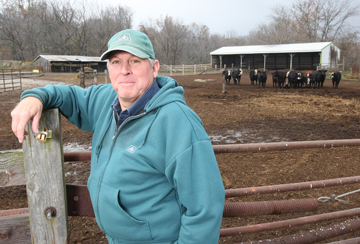Extension was wellspring of knowledge, advice during drought
February 5, 2013
 |
|
Daviess County farmer Paul Flint turned to
Purdue Extension for help during the 2012 drought. He hosted a regional meeting
in August that attracted many livestock producers. (Purdue Agricultural
Communication photo/Tom Campbell)
|
Paul Flint was like many producers trying to deal with problems wrought by the summer-long drought. He had concerns and questions about the condition of his crops and how to care for his 75 head of cattle.
As co-owner of Flint Farms in Daviess County in southwest Indiana, where the drought was at its worst, he wondered how he would feed his cattle as the intense heat and dry weather wilted crops and led to skyrocketing feed prices.
Purdue Extension specialists and educators knew that he and many other producers needed help -- and quickly. So they organized a series of regional meetings with crop farmers and cattle producers to help them get a firm handle on problems and find solutions. Flint's farm was the host site of one such meeting in August. He expected 10-15 fellow producers, but more than 50 showed up. Purdue Extension beef specialist Ron Lemenager explained possible solutions to the short forage supply and escalating feed costs.
"The people at Purdue put a lot of us at ease," Flint says. "They helped us to understand that it wasn't the end of the world. They calmed a lot of nerves."
A similar meeting held jointly by Purdue Extension offices in Cass and Carroll counties in northern Indiana drew 85 farmers, surpassing the 50 registered in advance. The program featured speakers who provided a variety of information on topics such as emergency-assistance programs and how to fill out a crop insurance claim. The meeting gave timely and relevant information from experts who understood the problems of producers in their local area, says Tamara Ogle, Purdue Extension agriculture and natural resources educator in Cass County.
As the drought intensified, Purdue Extension became a premier source of expert information for farmers and the general public in other ways, too. Among them:
* Corn specialist Bob Nielsen and soybean specialist Shaun Casteel spent much of their time driving throughout the state to examine crops and report on conditions. They consulted with farmers by telephone and email, and during Extension and industry field days.
* The Department of Agricultural Communication developed a website where producers, homeowners and other consumers could find timely information on many topics: the latest map showing the intensity of drought throughout the state; conditions of corn and soybean crops; how the drought was affecting water resources; and how homeowners could protect their vegetable gardens, trees and lawns.
* Extension specialists and the State Climate Office, based at Purdue, responded to daily requests for interviews from reporters in Indiana and with major news organizations such as the network stations, The New York Times, The Wall Street Journal, The Associated Press, Bloomberg and Reuters.
Agricultural economist Chris Hurt fielded several calls a day at the height of news interest in the drought. He gladly did so in the interest of keeping the public informed. "That's what I'm here for," he says.
A video story of how Purdue Extension helped farmers during
the drought of 2012 is available at http://www3.ag.purdue.edu/extension/makingadifference/Pages/story40.aspx.

